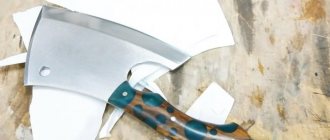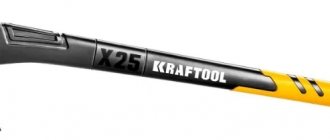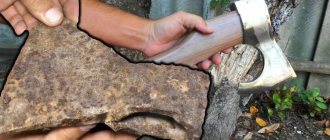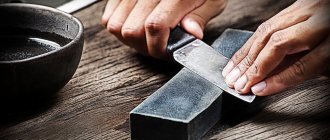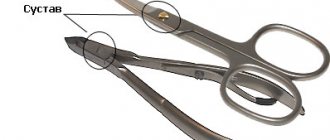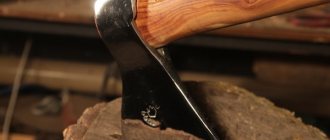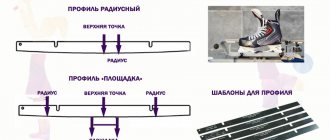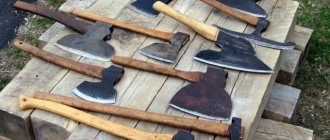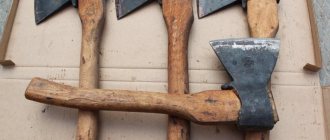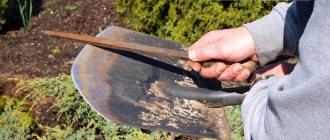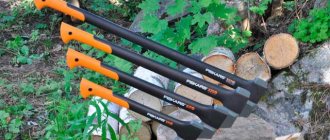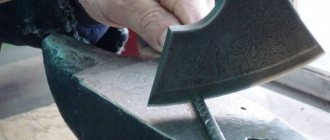A kitchen chopping hatchet is an indispensable tool not only for professional chefs, but also for ordinary people, because it allows you to chop even the thickest bones in just one movement. In addition, a high-quality ax for chopping meat is also useful in extreme conditions, because it is sharp and sweeping, and allows you to cut even large game.
All these advantages of kitchen hatchets will only be relevant if you choose the right product. In this article we will look at the main characteristics of axes for chopping meat, the main nuances that should be taken into account when choosing a tool, and also pay attention to the correct technology for sharpening the blade of a kitchen ax.
Kitchen hatchet: main characteristics
A butcher's ax differs from other kitchen tools in many ways. This tool outperforms even the highest quality steel knives from reputable brands and names. The fact is that in the process of cutting large bones, tendons or frozen foods, the knife blade can crumble or become dull, while a forged home ax allows you to do this work without much labor (Figure 1).
Among the main characteristics of kitchen axes it is worth highlighting:
- High strength:
the blade of such a tool undergoes a special hardening, thanks to which it can cut even the hardest and thickest bones in one movement, without becoming dull. - Reliability:
as a rule, a high-quality tool can serve its owner for many years without additional processing. Moreover, even constant use will not damage the blade. - Versatility:
With a durable and sharp blade, this tool is suitable for cutting even tough foods, including frozen meat and fish. In addition, it can be used not only in the kitchen, but also during outdoor recreation.
Figure 1. The main characteristics of kitchen hatchets - the comfort of the handle and the sharpness of the blade.
Externally, a kitchen hatchet also differs in many ways from an ordinary one. Firstly, it is less massive, but at the same time more comfortable. Secondly, kitchen models are one-piece, while ordinary ones consist of a separate handle and blade. Thanks to this design, the kitchen tool does not slip during operation, and its center of gravity is located exactly between the butt and the tip, which allows you to deliver precise blows that cut even the largest bones.
How to choose a quality hatchet for chopping meat
Blade rating
The blade shape can be straight or rounded, and this characteristic does not affect the functionality of the tool
It is important to determine the ratio of the thickness and weight of the hatchet - these parameters should be maximum. Only in this case can you count on the chopping properties of the hatchet
They use the hatchet with one hand, so the length of the handle should be within the palm of your hand. The shape of this part of the kitchen tool should be somewhat convex - this will ensure comfort when held in the palm of your hand for a long time.
It is imperative to make sure that there are several notches on the handle of the tool - this is a guarantee of safety when chopping meat/fish, because the palm will not slip and be injured.
If the kitchen tool is made in production, and not by “Kulibins”, then there will definitely be a mark on the head of the blade. It contains all the information about what steel was used in manufacturing.
Center of gravity
This indicator is important from the point of view of ease of use of the tool. According to the rules, the center of gravity should be located on the handle, but as close as possible to the blade. Only in this case will it be possible to expend less physical effort when chopping - the hatchet “itself” will cut the flesh and chop the bones.
It is not recommended to give a meat ax as a gift, even if a person really needs it and the product has high quality characteristics. The fact is that such tools are selected individually - the potential owner must hold it in his hand for several minutes, perform 2-4 swinging/chopping movements and evaluate the following parameters:
- comfort of the handle;
- product weight;
- center of gravity;
- handle dimensions;
- the presence of grooves for fingers and so on.
We suggest you familiarize yourself with Where do wasps winter, do insects sleep during the cold season?
Ax for chopping meat: basic requirements
A quality ax designed for chopping meat and bones is a very serious kitchen tool. As a rule, it is purchased for a long period of time, therefore the quality of the product should be as high as possible (Figure 3).
Some believe that the best hatchets are provided by Japanese manufacturers, but recently domestic brands have also been producing strong, reliable and durable models with comfortable handles and sharp blades.
When choosing a hatchet for the kitchen, you need to pay attention to the requirements for such a tool. Firstly, its blade must be made of high quality steel. The ease of use and a number of other factors will depend on this, in particular, notches will form on a high-quality blade less often, which means that such an ax will have to be sharpened much less often.
Figure 3. Main characteristics of the tool
Secondly, the handle of the hatchet should have an ergonomic shape and not be slippery. The ease of use of the tool will directly depend on this. In addition, pay attention to the overall weight of the product: the heavier the hatchet, the faster you will get tired while working. Also pay attention to the location of the center of gravity: it should be clearly between the butt and the handle. In this case, you can cut even the thickest bones in just one blow.
Axes for chopping meat. How to sharpen it correctly?
To chop meat, they use large, heavy axes, which make it possible to easily chop not only the flesh, but also the bones with just one blow. A special feature of such axes is their fairly wide blade, which allows them to chop meat in layers with just one movement. They are usually used in markets, as well as in restaurants, shops and supermarkets for professional meat cutting. In addition, they are also used on private farms.
Small axes are used for chopping small amounts of meat in the kitchen. They allow you to cut cartilage and small bones. A butcher ax must be properly sharpened. If its sharpening is not done correctly, then it will be difficult for them to butcher the carcasses of large animals.
The edge of the ax blade must be perfectly straight. The blade needs to be slightly rounded. It should be quite long. The sharpening angle should be the same as for knives.
sharpen an ax for chopping meat in specialized workshops in just half an hour. It is very important that the sharpening is correct; chopping meat will ultimately be safe.
You can sharpen it yourself, but it’s not that easy. It is important that the end result is a correctly formed chamfer. It represents a section of the blade, the width of which is ultimately
capable of determining the performance of an axe. If the chamfer is beveled, this can lead to difficulties in working. As a result, it will not be possible to quickly chop a large amount of meat, and at the same time it would also be even. And this is a huge disadvantage in being a butcher.
Specialists sharpen axes in several stages, and then perform final polishing. You can try sharpening yourself. The ax should be sharpened at approximately 40 degrees.
For sharpening, apexoids are sometimes used or done by hand. Sharpening musat can be taken from ceramics. A musat ( sharpener ) is a tool used for sharpening and straightening knife blades. It is similar to a file. It has an oval or round cross-section. It is used to straighten the blades of axes, which lose their sharpness during operation.
Musat is a rod with a handle. There are also opportunities to take a piece of a grinding wheel from a locksmith workshop. At the same time, it must be suitable in grain size. A diamond block is also great for sharpening an ax.
When preparing an ax, you should pay attention to the width of the chamfer and the sharpening angle. In this case, everyone chooses the last parameter themselves, taking into account their personal experience. The width of the chamfer is rarely changed.
The process of sharpening a tool requires attention. When using an electric sharpener, the work takes much less time. But at the same time, the metal may eventually overheat and this will have a bad effect on the hardness of the ax. So it's important to keep an eye on this. When sharpening, you should also monitor the condition of the surface of the wheel, and if necessary, it should be corrected. Then the sharpening will ultimately be of high quality.
When sharpening an ax, you should point its blade towards the rotation of the sharpener. In this case, the butt should be at an angle of about forty-five degrees. When sharpening a tool, it is necessary to gradually move it along the sharpener and achieve normal grinding of the chamfer.
Did you like the post? Share on social networks Or write your comment below ↓
Also see the post How to cook real Ossetian pies at home in Moscow
Correct tool sharpening technology
The technology for sharpening a professional meat ax is practically no different from a similar procedure for other piercing and cutting tools (Figure 5).
To carry out the procedure correctly, you must consider the following:
- The work area must be properly equipped. The sharpening tool must be firmly installed on the bed, and the bed must be attached to the floor so that it does not move during operation.
- Before starting work, carefully inspect the abrasive wheel: it must be absolutely smooth, without beating or nicks. Only in this case will you be able to sharpen it technologically correctly and without harm to the blade.
- Take care of personal protective equipment as well. First of all, you need to put on safety glasses. Kitchen hatchets are made of high-quality steel, and during the sharpening process, metal splashes and abrasive dust can fly in all directions and accidentally get into your eyes.
- The sharpening technology itself is as follows: the blade is held in the direction “away from you” towards the rotation of the circle and parallel to its axis. It is advisable to hold the ax with both hands so that you can accurately maintain the sharpening angle.
- During the process, try not to overheat the cutting edge. As a result, the steel of the blade may become too brittle and will crumble during further use.
Figure 5. Correct sharpening technology
If during sharpening you notice that a burr has accidentally formed on the blade, do not despair. This does not mean that the instrument is damaged. To correct the situation, simply turn the ax over and start sharpening it in the other direction. It is better to bring the cutting edge to the desired condition on a small abrasive wheel. At this stage, extreme care must be taken so that the edge of the chip does not break off, and the edge itself remains strong. To do this, it is best to use the double sharpening method.
At the final stage, you can check the sharpening angle of the blade using special templates and, if necessary, bring the product to perfection.
Chamfer size
This characteristic affects the sharpness of the ax blade, as well as the service life of the tool. However, it is very difficult to change this indicator at home, compared to choosing the sharpening angle. To change the width of the bevels, a significant amount of physical force must be applied and a lot of time must be spent. The procedure is no different from regular sharpening.
Heaps with greater height and width require higher pressure, and if the width and height are lower, the pressure must be lower. Delicate materials require a standard paraperson; Corrugated materials or height differences are cut using flexible paraprezin.
This is not a video game, this is not a model, this is not a weapon to fight with paints. Rather, we are faced with an item that comes from a very specific sector, consisting of the most phenomenal assembly of bolts, metal parts from a lathe, springs, gears and five magnificent elongated stones, manufactured in the factory using aluminum oxide. In fact, there was a sixth place in their place, but apparently Paul had no other available at the time of dispatch. Okay, now it’s better to clarify who Paul is; at least to the extent that we are given to understand it.
The chamfer is the distance from the axis of the blade to the surface of the ax. In some sources you can find such a name as descents (although this is the same thing). The correct sizes can be found from well-known manufacturing companies or famous craftsmen.
At the same time, such a tool does not need to be remade, and sharpening the blade is quick and easy.
That must be, in a nutshell, a Russian engineer. But the story is a little longer. In fact, it would be the inventor of a certain mechanism, based on the old concept of variable angle cutting scissors, fully customizable and equipped with a completely unprecedented design quality. So much so that it can be customized with its use, to paraphrase the words of an irritated reviewer, in itself a hobby worthy of occupying your long and passionate days of freedom. “Listen: it's very simple,” he said emphatically at the opening, creating an almost comical juxtaposition between the simplistic tone and the impressive array of components that are gradually displayed on the desktop, starting with this base of heavy metal, the appearance may be enough to fix the flag of the military -marine fleet, beaten by stormy sea waves.
So, to change the size of the bevels, it is necessary to remove excess metal from the ax to a certain size. To do this, use a method such as a pulling blade. This is an ancient and still widespread method, which involves constant sharpening. The end result is a lighter tool, which greatly simplifies the work.
Most manufacturers use low-quality metal when making blades, so changing the size of the chamfers has become commonplace. In order for the cutting quality to be higher, the dimensions of the sides should be slightly different.
So, immediately after this comes the time of the “heart” of the machine, that is, the mechanism that regulates the fixation and rotation of the knife to be processed simultaneously. And it's right here that things start to unravel from the supposed normalcy. There is a guide fitting for the locking clips, capable of 360 degree rotation, with embroidered extruders that snap into slots, allowing for smooth maneuvering of the entire set, always returning you nervous and ready to use on one side or the other.
Which, as we will see very soon, is absolutely necessary. The fact is, we are always taught through years and years of television advertising that technology products have the purpose of reducing the time we have to devote to certain activities. “No more cleaning, re-arranging, meticulously prepping food!” There's a gadget for every situation, and everyone can use the click of a button to eliminate tedious repetitive tasks from our agenda.
Chamfer width
If you are interested in how to properly sharpen an ax, you should remember that such a concept as the width of the chamfers plays an important role in this process.
Chamfer is the width of the bevel between two planes. This value can be one-, two- and three-sided. As a rule, in kitchen and carpentry axes, the dihedral width of the chamfers is used, and this indicator is not changed. However, the width of one of the chamfers of the cutting edge can be changed so that during the sharpening process it is possible to change the angle of its sharpening. As a rule, the optimal chamfer width is considered to be 18-20 mm.
Making an ax with your own hands
If you are interested in the question of how to make an ax, then remember that you will not be able to make a blade from scratch yourself. You can only give a regular blade the desired shape by processing it with a grinder or an emery wheel.
But it’s quite possible to make an ax handle. To do this you need:
- select a workpiece with a diameter of more than 120 mm and a length 200 mm longer than the planned handle;
- dry for several months at a temperature of 22-24 degrees and a humidity of 15%;
- using an ax or large knife, remove excess wood in accordance with the outlined contour;
- carry out processing with a chisel and hammer.
Now it is important to learn how to mount an ax correctly. This is done using gauze and epoxy resin.
The presence of a wedge provides better strength. After this, grinding is done, and the ax handle is varnished. Sharpening is done on a machine or manually.
An ax is a useful assistant both in the country and on a hike and when working in the forest. You just need to choose the right model, focusing on the required characteristics and workmanship of a particular instance.
Sharpening angles
The sharpening angle of any ax is one of the key indicators necessary for properly preparing the tool for work. The cutting ability of the tool will depend on this characteristic.
The choice of sharpening angle is influenced by several factors:
- Hardness of the processed material (bones, fresh or frozen meat);
- The moisture level of the material is an indicator that plays a greater role when choosing the sharpening angle of a carpenter’s axe, since dry wood splits much more easily than wet wood;
- The metal from which the blade is made also plays an important role. It is advisable to choose a product with the most durable steel. Of course, sharpening such an ax will present certain difficulties, but such a tool will last for a long time, even with constant use.
As a rule, ordinary kitchen axes have a sharpening angle of 25 to 30 degrees. But in order to accurately determine this value, you can cut a template from thin metal along the blade, attach it to the ax and check how well the estimated angle matches the desired one.
How to properly sharpen a carpenter's ax
To work on a grinding wheel, you will need to make a block with a bevel corresponding to the sharpening angle. They are used as a support for the tip.
The blade mounted on the block should be moved in a circle until the chamfer is completely adjacent to the surface of the sharpener. This method is quite labor-intensive and requires attention and perseverance.
Experts recommend another method. It will require:
- wire brush and rust converter liquid;
- sandpaper – hard, medium and velvet;
- safety glasses or clear face shield;
- polishing paste type GOI;
- a piece of felt fabric;
- bench vice;
- set of files;
- template or measuring ruler;
- double-sided grinding wheel;
- mineral lubricating oil;
- a piece of technical wax.
To sharpen an ax, you should perform the following operations:
- Clean the blade from rust and dirt.
- Clean it with coarse sandpaper.
- Sand with medium-grit sandpaper.
- Polish the surface with GOI paste.
- Secure in a vice.
- Use a brute file to sharpen the chamfer, bringing it to 12 mm. This will correspond to an angle of 25°.
- Brush away dust and sawdust.
- Perform final sharpening with a double-sided sharpener on the rough side, wetting the blade with liquid.
- Bring the edge to perfection with the soft side of the sharpener.
Sharpening an ax with a file
To complete the job, you need to apply a corrosion inhibitor liquid.
We use electricity
If you are interested in how to sharpen an ax using electric tools, we will provide several suitable options (Figure 6).
Figure 6. When sharpening an ax on an electric machine, the main thing is to prevent the metal of the blade from overheating
Firstly, a small hatchet for chopping meat can be sharpened using a special device - an electric sharpener. This is a rather large and expensive tool, but with its help you can sharpen not only hatchets, but also knives.
Secondly, you can use a special sharpening machine with an abrasive wheel installed on it. It is this device that allows for high-quality sharpening, but it should be borne in mind that this is an industrial tool, and working with it requires certain skills. It should also be taken into account that during the sharpening process the temperature of the blade may increase, which will deteriorate the quality of the metal and the cutting properties of the edge.
The butcher's ax is very correct
≡ 27 February 2018
← What is the most harmful thing about sausage? Which sausages cannot be faked?
How to choose a good hammer drill →
Professionals in their field talk.
It would seem that there is something special about it, but there are special features, and we will tell you a few words about them, because... The household must have a separate hatchet for chopping meat.
The destruction of bone under the influence of a chopping object follows slightly different principles than the destruction of wood. And bone is very different from wood in its strength, brittle-plastic properties and microstructure. I apologize, but I, as they say, “ate the dog” at the destruction of bones, that’s my profession. Therefore, tests on bones are completely inapplicable for axes intended for CUTTING WOOD. Bone and wood are materials with very different properties. Let me explain. Even a fairly dull ax that has difficulty sinking into wood can destroy bone quite easily. Bone has brittle-plastic properties. Initially, as a result of the impact of the blade, a cut is formed in the superficial parts of the bone. Bone as a structure, which has some plastic properties, is initially destroyed only in the area of impact of the blade. Further, under the influence of the wedging action of the axe, as a result of the complete consumption of the plastic reserves of the bone, a burst crack is formed, reflecting the brittle properties of the bone and propagating through the entire thickness of the bone at the speed of sound. Therefore, a massive wedge-shaped object, even if it does not have good sharpness, can destroy bone more easily than cutting wood. The main thing is sufficient mass, speed (together energy) and wedge.
From the side of the impact of the butcher's ax, the edges of the cut should be vertical, and on the opposite side, the line of the chopped fracture should deviate to the side, one edge hangs over, the other is undermined. The ax does not cut through the bone, but only cuts it, then completely destroys it due to wedging. These properties of the ax have nothing to do with cutting wood.
I heard such stories a couple of times from people who are completely trustworthy... Until the mid-60s, all any large food production in the USSR - for example, factory canteens and large restaurants - received meat in half carcasses. And the butcher was a very respected person back then. Let me emphasize - a good butcher.
As in any profession, butchers had their own criteria for skill... But the most important and obvious was the art of chopping tubular bones. A good specialist had no splinters - the cut was almost smooth.
Again, according to respected people, the secret lay in a high-quality instrument and a correctly placed blow.
The butcher ax - and I had to see them - had a blade in the form of a large and wide (sometimes very wide), but thin, sector. And the correct blow was a secant one. That is, when it collided with a bone, the ax blade continued its cutting, not chopping, motion.
Sometimes I linger in the markets next to the butchers and watch them chop. According to the fragments, indeed, sometimes the meat is chopped along the bones, but there are no fragments at all, as if with a circular saw. Most butchers do not cut tubular bones crosswise; they cut them at an angle relative to the conditional axis of the bone. The chip is even and smooth. (With bare bones - yes, you can do it at any angle. And when cutting meat with a bone, the main attention is on the meat. Cutting into the right parts is another butcher’s quality.)
Often you have to buy large pieces of meat only because the butcher at our market does not know how to chop meat. There are just a lot of fragments left from the tubular bones, especially on small pieces of 1.5 kg or less, so it’s easier to buy a large piece entirely and then cut it up yourself with a knife, and chop the bones for soup without meat.
Cutting all pork bones and spongy beef bones does not present any difficulty. But tubular beef bones are a different matter. If cut incorrectly, they shatter like glass into many small and sharp fragments. Then, no matter how thoroughly you wash the meat, this little thing still often gets into the food and causes trouble.
Here, for example, is a beef thigh bone. Here's a dumbbell:
For comparison, side by side pork thigh:
In order to avoid the appearance of fragments, we make the first cut not in the middle of the bone, but closer to some “ball” of our “dumbbell” and slightly diagonally. The point(s) of support of the bone on the deck should be as close as possible to the point of impact of the ax. Otherwise, if the support points of the bone are located at a distance from the impact, the bone bends, the ax blade is clamped by the bone being cut, and compression deformation appears at the clamping site, which leads to the appearance of fragments.
Next, cut each “ball” lengthwise. In general, the purpose of cutting these bones is to gain access to the bone marrow. Such bones make an excellent clear broth.
Our goal has been achieved - the bone marrow is available, there are no losses in the form of fragments, everything is going on sale.
The shape and length of the ax depends on the fact that when chopping meat, the chopper usually stands close to the chopping block. Therefore, the handle is short. As for the form, the situation here is like this. The hewer strikes with the ax as if with a “pull” towards himself and slightly upward. It is more convenient to make such a blow with an ax with a handle that has a downward slope. If the handle points upward, then it is also very inconvenient to “pull” upward.
In order for the blow to be a secant and the blade of the ax to continue the cutting movement, you need to chop with a pull, towards yourself. The butcher ax is heavy (3 kg), but with a thin sector, a wide swing, a strong blow is not needed, the main thing is to aim accurately and carefully lower it, it will chop off by itself, using its own weight. Well, the cutting there is of course fine and it sharpens sharply - you can shred meat. In the markets I saw many times how butchers wielded their axes with musat.
I once witnessed a friendly competition among butchers I knew at the market.
According to the terms of the competition, it was necessary to drive 1 kopeck into the deck with one blow, placed on its edge, and the blow of the ax fell ALONG the end of the coin. They got it!!! (But! Firstly, after a good blow, picking out a penny from the block will be very problematic. Secondly, the butcher’s ax, although it can chop metal, is intended only for cutting meat. Because of the metal in the block, sharpening will go down the drain. Also, competitions of cutting a match lying on a deck lengthwise into two equal parts are often practiced.)
However, you don’t often find good butchers. Many people don’t know how to work with butcher’s axes - picking out fragments is tiring. When there was still the Cherkizovsky market, I was amazed at how well the Vietnamese cut pork. They don’t even cut them up, but take them apart... Mostly they had Tramontino hatchets, sometimes their own - the Tsaidao system. Working with pork is a pleasure; only lamb is easier. But beef is “tough,” especially old beef.
Regarding fragments of tubular bones. Several factors influence the quality of cutting and, accordingly, the presence of fragments:
1. The sex of the animal (bull or heifer, boletus or pig) - the male has stronger bones.
2. Age of the animal.
3. The place where the animal is fattened is a private farmstead or a fattening complex. (well, it’s clear here, using the example of bones from chicken legs)
4. The area where the animal was fattened - using the example of the Voronezh region - if carcasses were brought from areas near the Don - then the bones in the carcass are strong like reinforcement - due to the high calcium content in the water, since the chalk in the Don region literally comes to the surface .
Experience, a good tool and a delivered blow equalize the above factors and the cutting area is obtained without splinters. Now about the tool. I have two axes - for pork and for beef. Weight with ax handles is 3 and 3.5 kg, respectively.
For beef, an ax with a rounded edge and a more massive butt. It's heavier because of the padding. A rounded edge, so that the blow is a secant and the ax blade continues the cutting movement, you need to chop with a pull, towards yourself. Let me add - with a pull towards you and upward, as if in a circle - which is problematic with a straight edge. Well, for pork - the edge is straight, the bones are easily chopped and the meat fibers are more tender and do not wrinkle from a direct blow.
Dimensions:
The axes have a safety bracket that prevents the ax head from jumping off the ax handle.
One day, revolutionary-minded students of Moscow University went out to demonstrate against the Tsar Father.
The demonstration was violent and numerous. The students overthrew the police line and marched along Mokhovaya towards the Kremlin.
Unfortunately for them, they had to go past Okhotny Ryad. The local butchers could not tolerate such outrage - they beat the demonstrators brutally and without any axes.
Moreover, the next day the butchers began to catch the young intelligentsia and force them to publicly swear their loyal feelings.
Those who refused, of course, were beaten for edification. And now the police had to drag the butchers away from the studios.
Great video on cutting up a pork carcass. With the exception of some nuances, our cut is identical.
Tags: interesting • how to choose • cooking • butchers • meat • professionals • ax
Comments:
Comments for the site Cackl e
Manual sharpening option
There are also quite a lot of tools for manually sharpening an ax blade. Their advantage is that you do not have to spend a lot of money to purchase the necessary device, and its small dimensions will allow you to store it in any kitchen drawer. The downside is the length of the sharpening procedure itself, especially if you are working with a meat cleaver with a large blade (Figure 7).
To cut meat in one motion, use the following hand sharpening tools:
- Musat:
as a rule, this tool is used for final straightening of the blade, and not for its direct sharpening. Externally, the musat is a long file rod with notches and an abrasive coating. Despite its limited functionality, it is still worth including the grinder in your arsenal of kitchen utensils, as it will help correct a burr on the blade or make it sharper in just a few movements. - Whetstone or Stone:
This is a more serious sharpening tool that is used to directly improve the sharpness of the blade of a kitchen ax or knife. If you want a truly sharp axe, it is better to buy several stones coated with different degrees of grain. - Special sharpening kits:
an ideal option for those who want to sharpen not only kitchen hatchets, but also knives, without going into the details of working with a whetstone or machine. As a rule, such sets include several stones coated with varying degrees of grain, a special fixing stand and additional accessories.
Figure 7. Tools for manual sharpening: sharpening kits, grinding stone and whetstone
If you are not a professional butcher and use an ax infrequently and exclusively at home, hand sharpening tools are ideal for you. But for those who, as part of their profession, often work with frozen meat or hard bones, it is better to give preference to sharpening the ax blade on special electrical appliances.
Sharpening angle
You also need to choose the optimal sharpening angle. For a construction ax it is 25-30°; carpentry tools are sharpened at 35°. The cleavers are sharpened at 40°. In this matter, the main importance is not so much the angle itself as the shape of the cutting edge. There are three types:
Figure 3 – Ax sharpening angle
- Straight. The chamfer is flat, uniform along the entire length of the blade.
- Convex. The chamfers stick out slightly.
- Concave. The chamfers are sunken, similar to a straight razor blade.
Straight chamfer is a universal option, suitable for any type of work. A convex chamfer is made when working with material of heterogeneous density, which greatly consumes the tool blade. A concave chamfer allows you to hold an edge for a long time, but is only suitable for more delicate, precise and neat work.
The process of sharpening an ax
Sharpening an ax properly requires attention and concentration. You will need:
You will need:
- a set of abrasive stones with different grains;
- a piece of rough cloth;
- measuring stick or protractor;
- water;
- The belt is usually made of genuine leather.
First you need to measure the current sharpening angle. This is done by applying a measuring block. The block is made with a bevel equal to the angle at which you decide to sharpen the tool.
to sharpen an ax, place it on a flat base (table, stool) and begin to draw a block along the blade, describing half rings. The block should be held at a sharpening angle. Coarse abrasive is used to restore the required slope and width of the chamfer. The operation is repeated on the other side of the blade.
Next, you should take a block with a medium grain and sharpen it on both sides. And finally, it’s the turn of the third, smoothest sharpener - it is used to remove burrs and the smallest irregularities. The surface of the chamfer should be smooth to the touch.
The testamentary operation is editing on a tense leather belt.
During work, the ax and abrasive bars must be moistened with water. Dust and small metal particles are removed with a piece of cloth.
During initial sharpening and in cases where the ax has become very dull, experts recommend removing it from the ax handle. And the tilt will be easier to maintain, and the handle will not get in the way.
Professionals use special sharpening devices - electric sharpening machines. There are adjustable stops for the sharpened tool, allowing you to sharpen it at a given angle.
